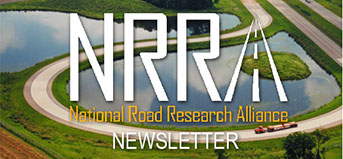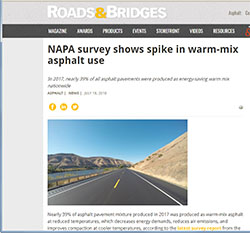NRRA Newsletter: July 2018 
Early Opening for Concrete Patching
Warm Mix Asphalt in Minnesota
By Michael Vrtis, Research Project Engineer, MnDOT
This document was originally written as a response to: “Why isn’t WMA used more in Minnesota?”
Minnesota has one of the highest uses of warm mix asphalt (WMA)* in the U.S. A review of the results is encouraging but closer inspections show there is potential to increase WMA usage. Here’s where WMA is being used in Minnesota--and why.
It’s important to note that MnDOT defines WMA as any mix produced at temperatures 30°F or lower than typical HMA mixing temperature of the asphalt binder. Water injection foaming is the most used type of WMA technology; however, it does not provide as much temperature reduction as chemical (surfactants) or organic (waxes) additives.
Two counties in Minnesota have been using chemical additives and achieved greater reductions in production temperature: Wright County and Crow Wing County. These two counties write into their specifications the use of chemical additives. However, they only allow surfactant products and have eliminated organic (wax) from the spec because of poor performance in cold regions.
 |
There’s more about WMA usage in a recent Roads and Bridges article. |
WMA additives are not being used in other counties or by MnDOT because the state’s specification is permissive in that it allows WMA to be used if the contractor chooses to do so. At this time, it is speculated the cost savings from energy reduction to produce WMA is not enough to offset the additional cost of the additives and injection equipment or not worth the additional risk for contractors to change their normal WMA operations.
Another limiting factor for WMA additives in Minnesota is the availability of asphalt binder predosed with WMA additives directly from the supplier. In the Pacific Northwest, WMA additives are blended into the binder at the asphalt refinery (or asphalt storage terminal) instead of being injected at the individual mixing plant during the time of production. In those cases, predosed binder with WMA additives can be purchased directly from suppliers with no special storage or equipment required when producing WMA. Producing WMA with predosed binder would appear to be simpler and make it more readily available for use.
Nevertheless, “we’ve been using the 58-28 WMA (chemical additive) in lieu of 58-34 HMA for several years now and are seeing good performance in thermal cracking resistance,” says Virgil Hawkins, County Highway Engineer for Wright County in Minnesota.
One of the interesting things that has come out of WMA additive usage in Crow Wing County is the use of PG 58-28 with WMA additive instead of using PG 58-34 HMA. The cost savings from the binder can offset the cost of the WMA and create a WMA mix that costs less than HMA. The long term performance has not been verified yet; the ability to evaluate the low temperature cracking performance from several of these projects would make interesting research, especially if compared to conventional HMA PG 58-34 performance.
Low temperature cracking laboratory tests and oxidation levels in the binder, from the same mix, with and without WMA additive, should also be considered. If it can be proven that there is equivalent performance with a WMA PG 58-28 as a HMA PG 58-34, then the usage of WMA will likely increase due to the cost savings on the binder.
*This number is likely inflated due to the loose definition of WMA that was used by the National Asphalt Paving Association (NAPA) survey. This survey defined WMA as a reduction in production temperature of 10°F. A lot of mix is produced in Minnesota using foamed WMA (water) which does not result in a large decrease in production temperature.
NCAT Fall Meeting
The NCAT northern meeting this year will be September 25-26, 2018. The agenda is currently being finalized, but it will certainly include tours of the northern NCAT test cells near Pease, MN. Please contact Ben Worel for more information.
Associate Profile: University of New Hampshire
Professor Eshan Dave at the University of New Hampshire’s College of Engineering and Physical Sciences is working on some of the most cutting-edge technology in the paving industry—drones, 3D printing, performance prediction. So what does he see when he looks into the future? Data, or more specifically, the ability to use analytics to handle all the data being generated by the paving industry.
“My far out look is that I hope that in five years we get to the point where pavement engineers are working together with analytics people,” says Dave. “My wish is that the analytics piece will make its way to pavement where we are able to fully realize the value of all the data we collect right now,” he adds.
Dave says he heard a commissioner of one DOT say “the irony of pavement engineering is that we are often data rich and information poor.” DOTs, says Dave, are required to gather data about all kinds of things—asset management, bridges, signs—but we need tools to handle all of the data. He compares it to drinking from a fire hose.
Predictive Modeling
We hear a lot about performance testing in the pavement industry. Dave and his team at UNH is interested in what happens after the performance testing is done: Performance Prediction. Says Dave, “It’s the next step and to some extent it’s unfortunate because it’s the step that oftentimes people don’t see or don’t invest a lot of time or energy into.”
He says performance testing can create too much of a binary system, segregating the mix design being tested into “good or bad” without taking all of the other conditions into consideration. For example, a mix may be labeled “poor” in terms of the performance test. But because it will be on a low volume road, it may be something road owners can live with. The same mix on a high volume road would be unacceptable.
Dave’s models build aging, climate, types of vehicles and more into the simulation. Then the data from the performance test is analyzed and his team can predict how many cracks the mix design might see after one winter as well as how moisture-related degradation would affect the IRI (international roughness index).
“We don’t have to wait for 10 or 12 or 15 years to see how these different alternatives perform. We are able to fast forward that time by using computers to do the simulation,” says Dave.
Drones
In a project for the Department of Defense, Dave and his team are working with drones to examine pavement from the air. In particular, his research is looking at roadways and runways and whether drones could be used in remote areas to see if black ice is present (Dave used to teach at NRRA member University of Minnesota Duluth, so he knows a lot about black ice). Likewise, he’s testing to see if drones can detect frost heave on runways. Both factors, he says, are important when landing very expensive aircraft in remote areas.
UNH is also looking at using drones for measuring the deflection on pavements on bridges using digital image correlation. If this works, it could significantly improve bridge inspections. We could “conduct bridge load tests without actually physically needing all kinds of gauges, which will lower costs substantially, and instead of having to shut down a bridge for half a day, you are looking at a matter of minutes,” says Dave.
Dave and his team are also looking at 3D printing of pavement, primarily in concrete. He wants to learn how to translate some of that work into the asphalt paving world. Of course, one of his big projects is working with the NRRA on rehabilitating concrete roads with asphalt overlay. All in all, Dave and the University of New Hampshire are on the cutting edge of many pavement technologies, and as a member of our alliance, they are pushing us all into the future.
New Report: Ultra-thin Bonded Wearing Course
There's a new report from MnDOT's Research Services titled Ultra-thin Bonded Wearing Course (UTBWC) Snow and Ice and Wind Effects (pdf). The project will "research the effects of snow and ice and wind on UTBWC applications, particularly the severity/speed of wind and the wind direction relative to the road."
We want to encourage and challenge all of our NRRA members to let us know about reports like this so we can get the word out through this newsletter. If you want to publicize your research, please contact Bob Filipczak.

